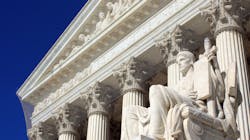Supreme Court Ruling a Setback for Federal Regulation of Power Plant Emissions
The same day Stephen Justice Breyer’s retirement becomes official and Judge Ketanji Brown Jackson is sworn in as the first Black woman on the Supreme Court, the EPA’s ability to regulate greenhouse gas emissions from existing power plants was curbed by a high court ruling.
In a 6-3 ruling, justices ruled that Congress had not given the EPA a clear ability via the Clean Air Act to issue regulations on the energy industry, as Chief Justice Roberts wrote in his ruling. Congress needs to act to pass such regulations, Roberts went on to write.
In her dissent, Justice Elena Kagan wrote that her court should not declare itself to be more an expert on energy than regulatory agencies or Congress.
The case itself, West Virginia vs. the Environmental Protection Agency, questioned whether the EPA could issue sweeping regulations on power plant emissions under the authority granted to it by the Clean Air Act, a 1963 law amended most recently in 2015 whose regulations on existing power plants had not yet gone into effect.
The Obama-era Clean Power Plan, an EPA rule, relied on the authority of the Clean Air Act to set limits on existing coal and natural gas power plants.
McGuireWoods environmental partner Allison Wood said the decision limits the potential actions that the federal government can take to address climate change, calling it a “stinging rebuke.”
“This rejection will limit what the Biden administration can do to regulate greenhouse gas emissions not just from existing power plants but also from existing sources in other industries as well,” Wood wrote.
Chris Carr, Chair of the Environment and Energy Practice at law firm Paul Hastings, said the decision does not formally shut the door to EPA regulating via the Clean Air Act, as the decision was limited to what the act's Section 111(d) does not authorize.
“[The decision] is limited to holding that Section 111(d) does not authorize the Clean Power Plan's ‘generation shifting’ approach, and doesn't address whether EPA only has the authority to adopt measures "inside the fence" (i.e., at the individual source level),” Carr wrote.
Gregory Wetstone, President and CEO of the American Council on Renewable Energy (ACORE), said the court’s ruling removes an important means of achieving an energy transition away from fossil fuels.
“We are deeply concerned about today’s Supreme Court ruling and its broader repercussions. At a time when we should be using the most powerful tools in our toolbox to combat the climate crisis, the Supreme Court is blunting our key instruments. Curbing the EPA’s authority to regulate greenhouse gas emissions will inevitably hinder America’s climate progress and negatively impact the world we leave to our children and theirs,” Wetstone wrote.
About the Author
Jeff Postelwait
Managing Editor
Jeff Postelwait is a writer and editor with a background in newspapers and online editing who has been writing about the electric utility industry since 2008. Jeff is senior editor for T&D World magazine and sits on the advisory board of the T&D World Conference and Exhibition. Utility Products, Power Engineering, Powergrid International and Electric Light & Power are some of the other publications in which Jeff's work has been featured. Jeff received his degree in journalism news editing from Oklahoma State University and currently operates out of Oregon.
